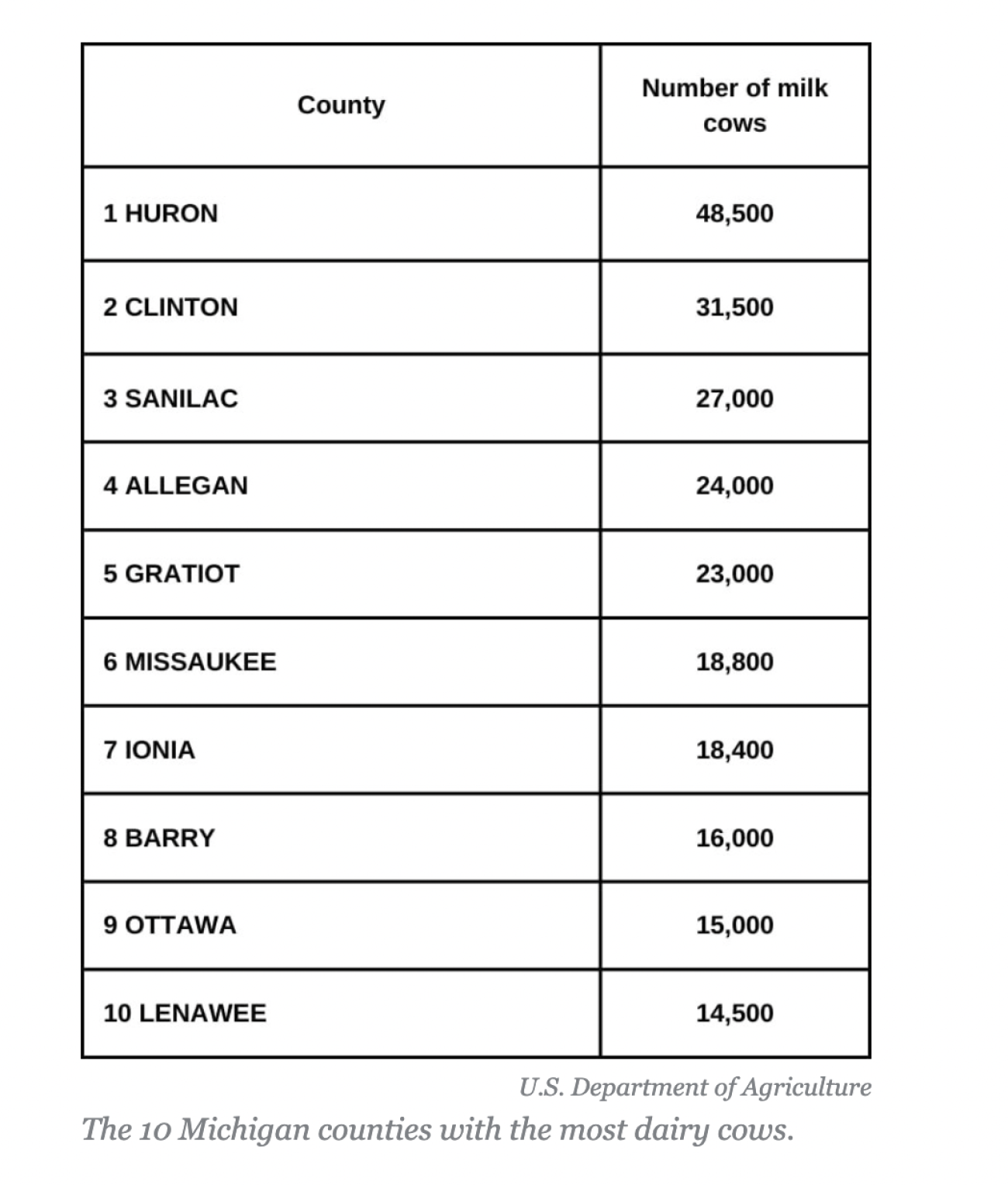Michigan cows are nation's top milkers. Their secret: Good diets, clean living

LANSING — Michigan ranks No. 1 in the country for producing the most milk per cow — and has been for the past few years.
Although not the nation’s biggest overall milk producer, the state’s specialty in dairy has led farmers to find the most efficient way to get more milk from their herds.
Cows produce more milk because of three main factors: their feed, their environment and how comfortable they are. Fortunately, Michigan farms excel in all three, according to Michigan State University animal science professor Adam Lock.
Jolene Griffin, the vice president of industry relations at United Dairy Industry of Michigan, said that diet planning is a specialty in the state.
Related:
- Hunting season in Michigan: What to know about licenses, seasons, limits
- Michigan House committee advances wind, solar permitting bills
- Gone nearly a century, Michigan anglers can again catch Arctic grayling
“We want our cows to have all of the nutrients that they need — they rely on us for food,” she said. “You and I might meal prep for a weekend or a couple of days, but as dairy farmers, we’re meal prepping for an entire year for our cows.”
“For lunch, I had two packages of little M&Ms — I don’t have anybody making a balanced diet for me, but we have to for our cows,” Griffin said.
Dairy cows on average eat around 100 pounds of food per day.
Through the abundance of dairy research in the state, experts have found that cows can eat things like corn silage, cottonseed and sugar beet pulp because they are ruminants.
They have multiple stomachs that can ferment feed before digestion, making them able to consume nutrients from foods that humans can’t consume.
“Cows are metabolic marvels,” Griffin said.
That’s why farms are able to stay sustainable and efficient by using all parts of certain plant-based food — so there is no waste, she said.
Sustainability of the land also has a lot to do with the health of the state’s cows.
Lock said, “Michigan has an abundance of freshwater access, which is good for the nutrients of the cows.”.
“The dairy cows also have a lot of freshwater access, so you can already see things that are stacking up for us compared to other states,” Lock said. “But I think that the progressive nature of our industry and our producers in the state is what allows them to pick up the latest ideas or technologies.”
Agriculture is the state’s second-biggest industry with the dairy industry leading that category. There are over 900 dairy farms in the state. Within the past 20 years, the number of cows in the state has grown by 14 percent.
The most are in the Thumb area — topped by Huron County with 48,500 dairy cows.
Among the other top 10 leaders are Clinton County with 31,500 cows, Allegan County with 24,000, Gratiot County with 23,000 and Ionia County with 18,400.
This year there are around 432,000 milk cows in the state according to the U.S. Department of Agriculture.
Lock said, “These high-producing dairy cows have minimum stresses, and we provide them with all of the nutrients that they need to make the milk in a safe and comfortable environment.”
He said, “We have to house them in comfortable facilities in terms of physical comfort nests and the environment. The example I give is if you have the flu today, you’re much less efficient — you’re not as productive.”
Griffin agreed.

“A cow who is not taken care of, a cow who doesn’t have all of her needs met or a cow that might be scared of people around her is not going to give milk,” she said. “We do everything that we can to keep them content and provide barns for them where they’re going to be safe. We keep their best interests at mind.”
According to Lock, the state also has healthy nutrients in its soil and freshwater for the cows.
He highlighted the importance of research.
“There’s no point in us doing something if it just stays within the university. It has to be applied and utilized on farmland,” he said.
“For 100 years now, we’ve had continual advancements in our understanding of animal sciences, nutrition, milk production and reproduction — they all come together.”
And Griffin said.
“My parents and my brother don’t farm the same way that my great-grandparents farmed because we have better technology, we have better equipment and we have better ways of knowing how to take care of our calves.”
This story was originally published by the Capital News Service.
Michigan Environment Watch
Michigan Environment Watch examines how public policy, industry, and other factors interact with the state’s trove of natural resources.
- See full coverage
- Subscribe
- Share tips and questions with Bridge environment reporter Kelly House
Michigan Environment Watch is made possible by generous financial support from:
Our generous Environment Watch underwriters encourage Bridge Michigan readers to also support civic journalism by becoming Bridge members. Please consider joining today.
See what new members are saying about why they donated to Bridge Michigan:
- “In order for this information to be accurate and unbiased it must be underwritten by its readers, not by special interests.” - Larry S.
- “Not many other media sources report on the topics Bridge does.” - Susan B.
- “Your journalism is outstanding and rare these days.” - Mark S.
If you want to ensure the future of nonpartisan, nonprofit Michigan journalism, please become a member today. You, too, will be asked why you donated and maybe we'll feature your quote next time!






